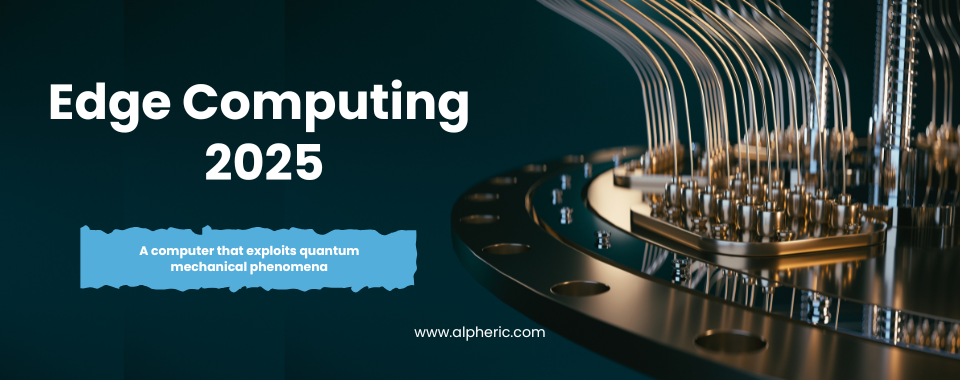
Edge computing is a modern way of processing data where information is analyzed closer to its source rather than being sent to a centralized cloud or data center. This approach speeds up decision-making, reduces delays and improves overall efficiency. It is particularly useful for businesses dealing with large volumes of data, such as those using IoT (Internet of Things) devices.
In simple terms, edge computing allows devices like smart cameras, sensors, and industrial robots to process data on-site instead of relying on distant cloud servers. This reduces bandwidth usage and ensures faster responses, which is crucial for applications requiring real-time actions.
Why is Edge Computing Important?
With the rapid growth of IoT and 5G technology, the number of connected devices has increased significantly. These devices generate a massive amount of data, much of which goes unused due to bandwidth limitations and network congestion. Traditional cloud computing struggles to handle this surge in data efficiently.
Edge computing solves this issue by enabling devices to process data locally before sending only necessary insights to the cloud. This reduces latency (delay in response time), enhances security and lowers costs by minimizing the need to transmit large amounts of raw data over networks.

How Edge Computing Works
Instead of sending all data to centralized cloud servers for processing and allows data to be processed closer to its origin. Here’s how it works:
- Data Collection: Devices such as sensors, cameras or IoT gadgets collect raw data.
- Local Processing: A nearby edge device (e.g., an edge server or gateway) processes and analyzes the data.
- Decision-Making: Based on real-time analysis, actions are taken immediately (e.g., alerting a factory worker about a malfunctioning machine).
- Data Transfer: Only essential insights or reports are sent to the central cloud for storage or further processing.
This process improves efficiency by reducing the amount of data that needs to travel over the network, saving bandwidth and reducing response time.
Devices at the Edge
From self-driving cars to smart factories, edge computing is revolutionizing multiple industries. However, studies show that a significant portion of the data generated by IoT devices is never used. For example, an offshore oil rig with 30,000 sensors collects a vast amount of data, but less than 1% of it is utilized for decision-making.
By exploiting the power of edge computing, businesses can use this untapped data to make better, faster decisions. The ability to analyze data closer to the source allows companies to optimize operations, improve safety and enhance customer experiences.
Benefits of Edge Computing
Here are some key advantages of implementing edge computing:
- Faster Decision-Making
Since data is processed locally, devices can respond to critical situations in real-time. For example, a self-driving car needs to process road conditions instantly to avoid accidents. - Reduced Latency
Unlike cloud computing, where data travels long distances, edge computing minimizes delays, making it ideal for applications that require immediate responses, such as online gaming and video surveillance. - Improved Security and Privacy
Edge computing reduces the risk of cyberattacks by keeping sensitive data closer to its source. It also helps organizations comply with data privacy regulations by processing data locally. - Efficient Bandwidth Usage
Instead of sending massive amounts of raw data to the cloud, edge computing allows only relevant insights to be transmitted. This reduces network congestion and lowers operational costs. - Business Continuity
In industries like retail and healthcare, internet connectivity issues can disrupt operations. Edge computing ensures critical applications continue running even when the network is down.
Challenges in Edge Computing
While it offers numerous advantages, there are also challenges to consider:
- Security Risks
Since edge devices process data independently, they need strong cybersecurity measures to prevent unauthorized access or breaches. - Management Complexity
Deploying and maintaining multiple edge devices across different locations can be complex and require advanced IT infrastructure. - Scalability Issues
Organizations need a well-planned strategy to scale their edge computing solutions efficiently without compromising performance or security.

Edge Computing in Different Industries
Many industries are using edge computing to enhance their operations. Let’s explore how it is transforming various sectors:
- Retail
- Personalized shopping experiences based on real-time customer data analysis.
- Faster checkout processes using AI-powered self-service kiosks.
- Banking
- Real-time fraud detection by analyzing transaction data at ATMs.
- Improved security through facial recognition and AI-driven risk analysis.
- Healthcare
- Remote patient monitoring using wearable devices that analyze vital signs instantly.
- Faster diagnosis and treatment planning through AI-powered medical imaging.
- Manufacturing
- Predictive maintenance to prevent machinery breakdowns and reduce downtime.
- Quality control using real-time video analysis in production lines.
- Smart Cities
- Traffic management using AI-driven analysis of real-time data from cameras and sensors.
- Enhanced public safety through instant crime detection and emergency response systems.
The Future of Edge Computing
It is expected to play a crucial role in building the future of technology. With the rise of 5G networks, AI and advanced IoT devices, the demand for real-time data processing will continue to grow. Here are some trends to watch:
- AI Integration: Edge devices will become smarter with AI-driven automation, enabling advanced decision-making without human intervention.
- Decentralized Networks: Businesses will rely more on localized data processing rather than centralized cloud models.
- Edge-as-a-Service (EaaS): Companies will adopt edge computing solutions offered by service providers, making it easier to implement and scale.
- Increased Cybersecurity Measures: As edge computing grows, stronger security frameworks will be essential to protect sensitive data.
Conclusion
Edge computing is revolutionizing the way data is processed, analyzed and used. By bringing computing power closer to data sources, businesses can achieve faster insights, improve operational efficiency and reduce costs. While challenges like security and scalability exist, the benefits of edge computing far outweigh the risks.
As industries continue to adopt edge computing, the future holds exciting possibilities for AI-driven automation, real-time analytics and enhanced customer experiences. Whether in retail, healthcare, banking or smart cities, edge computing is unlocking new opportunities for innovation and efficiency.
If you’re a business looking to improve data processing and make smarter decisions in real-time, now is the time to explore the power of edge computing. Explore more insights at Alpheric!







